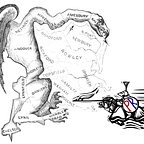PLACE voting example: North Carolina, 2018
This is an example of how PLACE voting could work in US House elections in North Carolina, 2018. PLACE voting is a proportional representation (pro-rep) vote-counting method which solves gerrymandering by ensuring that almost all voters are represented equally no matter where district boundaries are, without needing to change those boundaries or the voting machines.
Note: this article covers the technicalities of the PLACE process. I’ll write another article in a few days to make less-technical points about why this is a good idea.
If you were voting in NC’s second district, a PLACE ballot would look something like this:
As you can see, the task for voters is simple: just choose a favorite candidate. That can be either one of the local candidates listed explicitly on the ballot, or a candidate from another district, via write-in.
You can also see that this ballot says that if your chosen candidate loses, your vote will transfer to another candidate in the same party. Thus, as candidates are eliminated one by one, votes will be transferred from less-popular candidates to more-popular ones.
Specifically, your vote will go to the candidate with the most votes, of those “faction allies” pre-endorsed by your chosen candidate. For instance, for this hypothetical district-2 sample ballot, I show that the local Democratic candidate, Linda Coleman, pre-endorsed David Price (d4), Kyle Horton (d7), and Alma Adams (d12).¹ If all the pre-endorsed candidates have either won their seats or been eliminated, then your vote will transfer to a same-party candidate who wasn’t pre-endorsed; and if all of them have won or been eliminated, then your vote will go to one of the “coalition allies” pre-endorsed by your candidate. For instance, Republicans might endorse Libertarians as coalition allies, so that if Republicans didn’t have enough votes left for another seat, their leftover votes would go to any remaining Libertarians.
Here’s how the elimination process might go² in this election: (for a full list of PLACE rules, see this FAQ).
Here’s the order of eliminations and transfers you can see in the “vote flow graph” above (skip these if you get it from just the graph):
- First the weakest candidate, the Republican in district 12 is eliminated, transferring their votes to district 10
- Then the next-weakest, the Republican in 1, whose votes go to the R in 6
- Then R 4 transfers to R 6.
- This gives R 6 enough votes to win a seat (100% of the average district), so D 6 is knocked out, transferring enough votes to D 4 to bring them up to 100%, and the remainder to D 8.
- D 3 tops up D 1, plus a tiny leftover to D 2.
- D 10 is knocked out and transfers to D 8, plus a leftover to D 9. (A slight bug in my graphing code shows the 9 transfer happening later.)
- R d8 is knocked out and transfers to the Rs in 10 and 11.
- D d11 is knocked out and transfers to the Ds in 9 and 12.
- D 5 transfers to D 2.
- R 9 to R 7
- D 7 is knocked out to D 9 and D 13 (and an almost-invisible bit to D 2)
- R 2 is knocked out, to R 3, R 5, and R 11.
- R 13 transfers enough votes to R 5 to get her to 100%. A small leftover of wasted votes remains with R13.
Thus, at the end, less than 2% of the statewide votes (a few Republican votes from primarily-Democratic district 13) end up wasted. Compare this to the current choose-one voting method, where at least half of the votes are wasted (and perhaps more, when there are strong candidates from more than two parties):
Finally, in PLACE, after all winners are determined, the parties assign their winners extra territory, so that their voters in districts they lost have a representative. For instance, District 2 Democrat Linda Coleman might get District 3 as extra territory. Voters in District 3 could then petition either Coleman or their Republican representative (or both), depending on which they thought would listen to their concern.
Footnotes
¹In order to decide which of their co-party-members each candidate would have pre-endorsed, I looked at endorsements from groups such as the NRA or Emily’s list, and assumed that each candidate would pre-endorse the others with the most endorsements in common. I counted similar genders and similar races as one common endorsement each.
²I’ve used The Hot Seat’s model (based on historical results, funding totals, and polls) to give initial vote totals. For simplicity, I’ve assumed that no voter would write-in a candidate from another district. In fact, if cross-district voting was a factor, it might help further improve the gender and racial balance of the results, as well as giving voters more of a say in what ideological faction of their party had power. It would also allow voters to kick out a corrupt incumbent, even in a safe district, without punishing the entire party.
